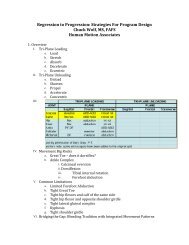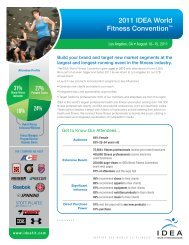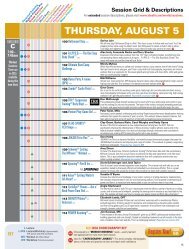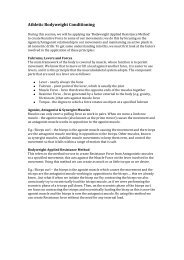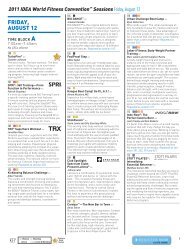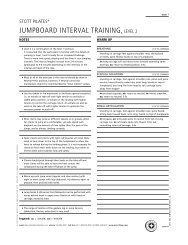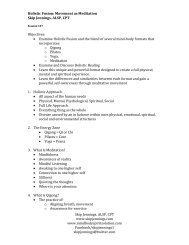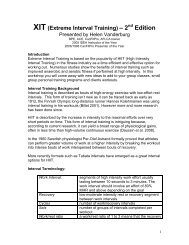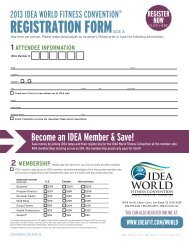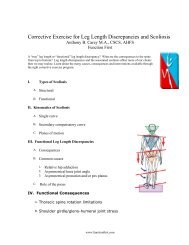Lesson #1: LT Pace Types of LT Workouts Lactic Acid Lactic ... - Idea
Lesson #1: LT Pace Types of LT Workouts Lactic Acid Lactic ... - Idea
Lesson #1: LT Pace Types of LT Workouts Lactic Acid Lactic ... - Idea
Create successful ePaper yourself
Turn your PDF publications into a flip-book with our unique Google optimized e-Paper software.
2012 IDEA World Fitness Convention<br />
Top 7 <strong>Lesson</strong>s For Training<br />
Runners<br />
©Jason Karp, Ph.D.<br />
RunCoachJason.com<br />
Founder/Coach, REVO2<strong>LT</strong> Running Team TM<br />
Freelance writer & author<br />
2011 IDEA Personal Trainer <strong>of</strong> the Year<br />
<strong>Lesson</strong> <strong>#1</strong>:<br />
Run for gold by training the lactate<br />
threshold.<br />
The lactate threshold (<strong>LT</strong>) is the best physiological<br />
predictor <strong>of</strong> distance running performance. It demarcates<br />
the transition between running that is almost purely<br />
aerobic & running that includes significant oxygenindependent<br />
(anaerobic) metabolism. It represents the<br />
fastest speed runners can sustain aerobically. <strong>LT</strong> runs<br />
raise <strong>LT</strong> to a faster speed, allowing runners to run faster<br />
before they fatigue. The longer the race, the more<br />
important <strong>LT</strong> training becomes.<br />
<strong>LT</strong> <strong>Pace</strong><br />
• Slower/recreational runners:<br />
• 6-9 sec/km (10-15 sec/mile) slower than 5K<br />
race pace (or ~10K race pace)<br />
• 75-80% max HR<br />
• Highly-trained/competitive runners:<br />
• 15-18 sec/km (25-30 sec/mile) slower than 5K<br />
race pace (or 9-12 sec/km or 15-20 sec/mile<br />
slower than 10K race pace)<br />
• 85-90% max HR<br />
• Subjectively feel “comfortably hard”<br />
<strong>Types</strong> <strong>of</strong> <strong>LT</strong> <strong>Workouts</strong><br />
Continuous <strong>LT</strong> Runs<br />
5-7K (3-4 mi) up to 11-13K (7-8 mi) (or ~45 min)<br />
<strong>LT</strong> Intervals<br />
intervals @ <strong>LT</strong> pace with short rest periods<br />
4 x 1,600 metres (1 mi) @ <strong>LT</strong> pace w/ 1 min rest<br />
<strong>LT</strong>+ Intervals<br />
short intervals @ slightly faster than <strong>LT</strong> pace with very short<br />
rest periods<br />
2 sets <strong>of</strong> 4 x 1,000 metres @ 10 sec/mile faster than <strong>LT</strong> pace<br />
w/ 45 sec rest & 2 min rest between sets<br />
<strong>LT</strong>/LSD Combo Run<br />
medium-long runs with portion @ <strong>LT</strong> pace<br />
19-25K (12-16 mi) w/ last 3-6K (2-4 mi) @ <strong>LT</strong> pace<br />
3K easy + 5K @ <strong>LT</strong> pace + 10K easy + 5K @ <strong>LT</strong> pace<br />
<strong>Lactic</strong> <strong>Acid</strong><br />
<strong>Lactic</strong> <strong>Acid</strong>: Fatigue’s Faulty<br />
Scapegoat<br />
• First discovered in 1780 in sour milk.<br />
• Produced in a metabolic pathway called<br />
glycolysis.<br />
• In the 1920s, Nobel Prize winners A.V. Hill and<br />
Otto Meyerh<strong>of</strong> discovered that lactic acid is<br />
produced during fatiguing muscle contractions<br />
in the absence <strong>of</strong> oxygen.<br />
• Lactate causes fatigue<br />
• Lactate causes muscle burning<br />
• Lactate causes muscle soreness<br />
At physiological pH, lactic<br />
acid exists as lactate.<br />
©2012 Dr. Jason Karp. All rights reserved.
Lactate DOES NOT Cause Fatigue!<br />
There has never been any experimental<br />
evidence proving a cause-and-effect<br />
relationship between lactate and fatigue.<br />
While lactate increases during intense<br />
exercise, so do other metabolites,<br />
including K + , H + , ADP, & Pi, all <strong>of</strong> which<br />
have been implicated in fatigue. Because<br />
<strong>of</strong> lactate’s concomitant increase with<br />
these other metabolites and the simple<br />
method <strong>of</strong> measuring its concentration,<br />
blood lactate is used by scientists only as<br />
an indirect measure <strong>of</strong> acidosis.<br />
Lactate DOES NOT Cause Muscle<br />
Burning!<br />
No physiologist has ever burnt himself when<br />
taking a blood sample containing a high blood<br />
lactate concentration. The exact cause <strong>of</strong> the<br />
sensation <strong>of</strong> muscle burning is unknown, but it<br />
may be nothing more than the increase in<br />
muscle temperature that accompanies intense<br />
exercise.<br />
Lactate DOES NOT Cause Muscle<br />
Soreness!<br />
Muscle and blood lactate return to pre-exercise<br />
levels within 30 to 60 minutes after exercise, so<br />
lactate is long gone by the time soreness<br />
develops. Muscle soreness is the result <strong>of</strong><br />
microscopic tears in the muscle fibers, causing an<br />
initial mechanical injury (likely related to the<br />
contractile proteins—actin and myosin—pulling<br />
apart), and a delayed biochemical injury, which<br />
usually brings about the perception <strong>of</strong> soreness.<br />
Lactate is Your Friend<br />
• Lactate production supports continued<br />
production <strong>of</strong> energy (ATP) from glycolysis<br />
• Used as fuel by heart<br />
• Used by liver to make new glucose<br />
(gluconeogenesis)<br />
• Converted back into glycogen by a reversal <strong>of</strong><br />
glycolysis<br />
• new glucose & glycogen used as fuels by muscles<br />
so high-intensity exercise can continue<br />
• <strong>Lactic</strong> acid & ↓ pH have been shown to ↑ in vitro<br />
muscle force production<br />
<strong>Lesson</strong> #2:<br />
To prevent runners’ fitness levels from<br />
waning, ramp up the intensity with<br />
VO2max training.<br />
VO2max is the second major player <strong>of</strong><br />
running performance. While increasing<br />
runners’ weekly running mileage will<br />
increase their VO2max if they currently run<br />
less than 65-80K (40-50 mi) per week,<br />
interval training (w/3-5 min bouts @ 95-100%<br />
VO2max) is most potent stimulus to increase<br />
it, especially for trained runners.<br />
VO2max Training<br />
VO2 = SV x HR x (a-v O2 difference)<br />
VO2 = CO x (a-v O2 difference)<br />
Central factors<br />
Peripheral factors<br />
• Mileage targets peripheral factors<br />
• Interval training targets central factors<br />
©2012 Dr. Jason Karp. All rights reserved.
VO2max <strong>Pace</strong><br />
• Running speed that elicits VO2max<br />
• Fastest speed that can be<br />
maintained for ~7-10 min<br />
• 95-100% max HR<br />
• Slower/recreational runners:<br />
• 1,600-metre to 2,400-metre race pace<br />
• Highly-trained/competitive runners:<br />
• 3K (2-mile) race pace<br />
VO2max Interval <strong>Workouts</strong><br />
• 4 x 1,000 metres @ VO2max pace w/ 1:≤1 work:rest ratio<br />
• 6 x 800 metres @ VO2max pace w/ 1:≤1 work:rest ratio<br />
• 16 x 400 metres @ VO2max pace w/ 1:
<strong>Lesson</strong> #6:<br />
Run through town, put dumbbells down.<br />
There is little evidence that weight training improves<br />
distance running performance. Distance running is<br />
primarily limited by the delivery and use <strong>of</strong> oxygen.<br />
There are no studies proving that weight training<br />
increases the supply <strong>of</strong> oxygen to and use by muscles,<br />
which is largely dictated by the amount <strong>of</strong> blood<br />
pumped by your heart per minute (cardiac output),<br />
the amount <strong>of</strong> RBCs & hemoglobin in your blood, and<br />
your muscles’ capillary and mitochondrial densities.<br />
However, when done to increase power, weight<br />
training can improve running economy…<br />
<strong>Lesson</strong> #6 (cont.):<br />
Weight training is not necessary unless<br />
1) runners have either already maximized their<br />
running training by increasing both mileage &<br />
intensity<br />
2) they cannot handle physical stress <strong>of</strong> running more<br />
miles<br />
3) they have reached their genetic limit for<br />
adaptation to their running training<br />
A 25-minute 5K runner is better served by<br />
improving the cardiovascular & metabolic<br />
parameters associated with endurance than by<br />
weight training.<br />
<strong>Lesson</strong> #7:<br />
To run your best race, run even or<br />
negative pace.<br />
The best way to run a race is by starting out at the<br />
pace that can be maintained the entire race, with<br />
second half equal to or slightly faster than first half<br />
(negative splits). The faster runners run the first<br />
couple <strong>of</strong> kilometres, the more they rely on anaerobic<br />
metabolism, which is accompanied by muscle & blood<br />
acidosis & accumulation <strong>of</strong> metabolites that cause<br />
fatigue. Running time cannot be put in the bank.<br />
Runners’ workouts are invaluable for providing<br />
knowledge <strong>of</strong> their fitness levels and for predicting<br />
their average race paces.<br />
©2012 Dr. Jason Karp. All rights reserved.



